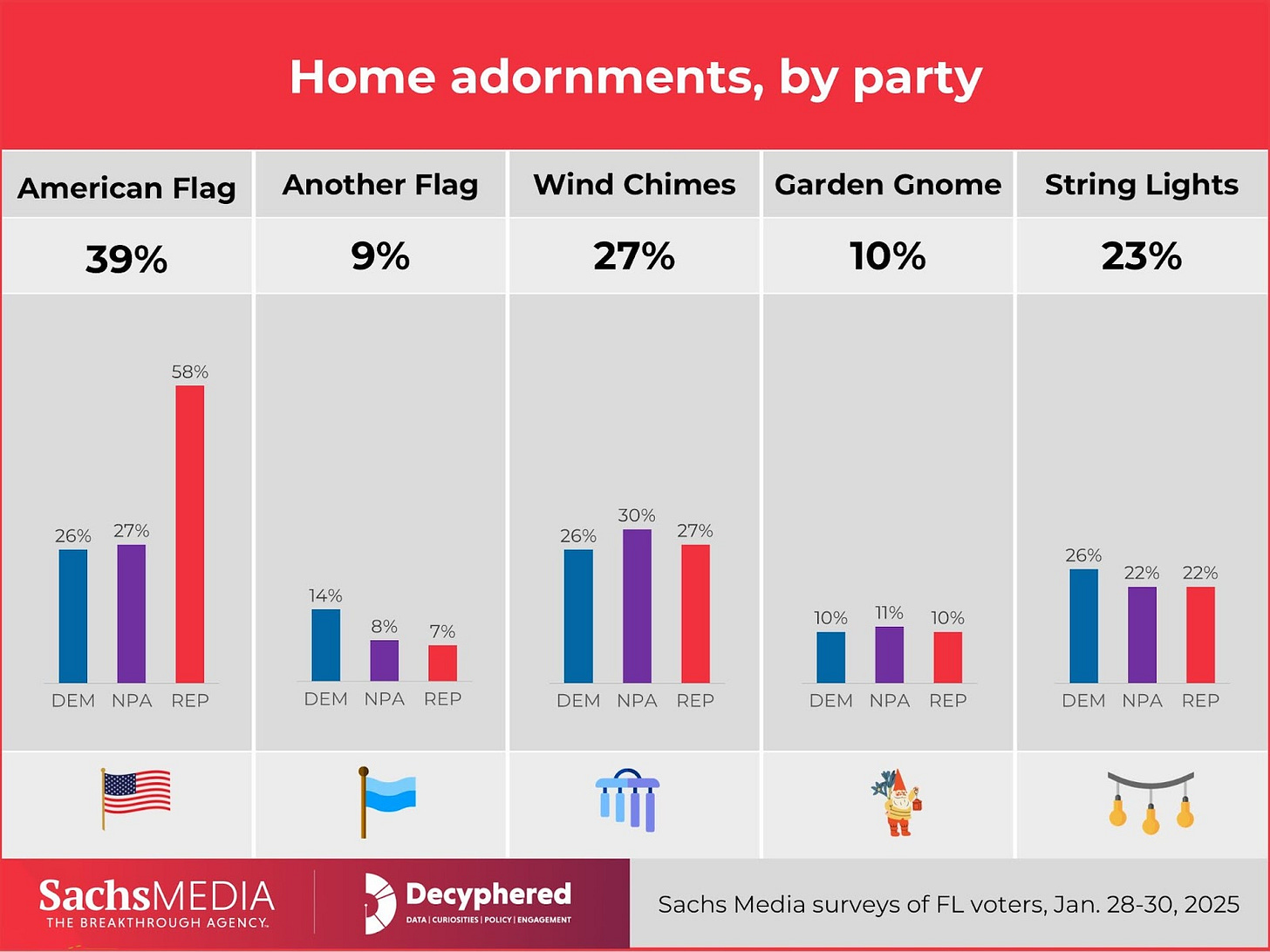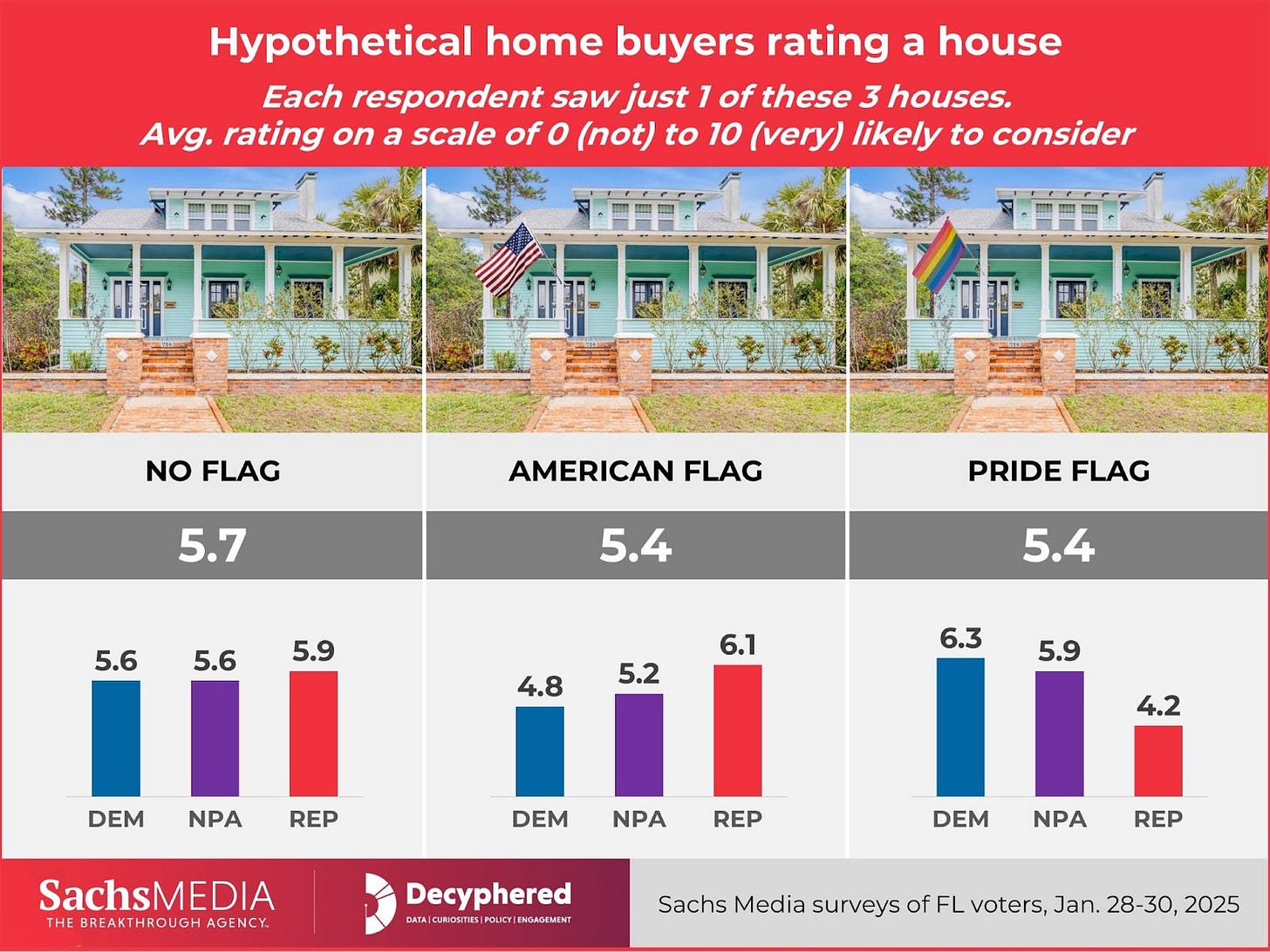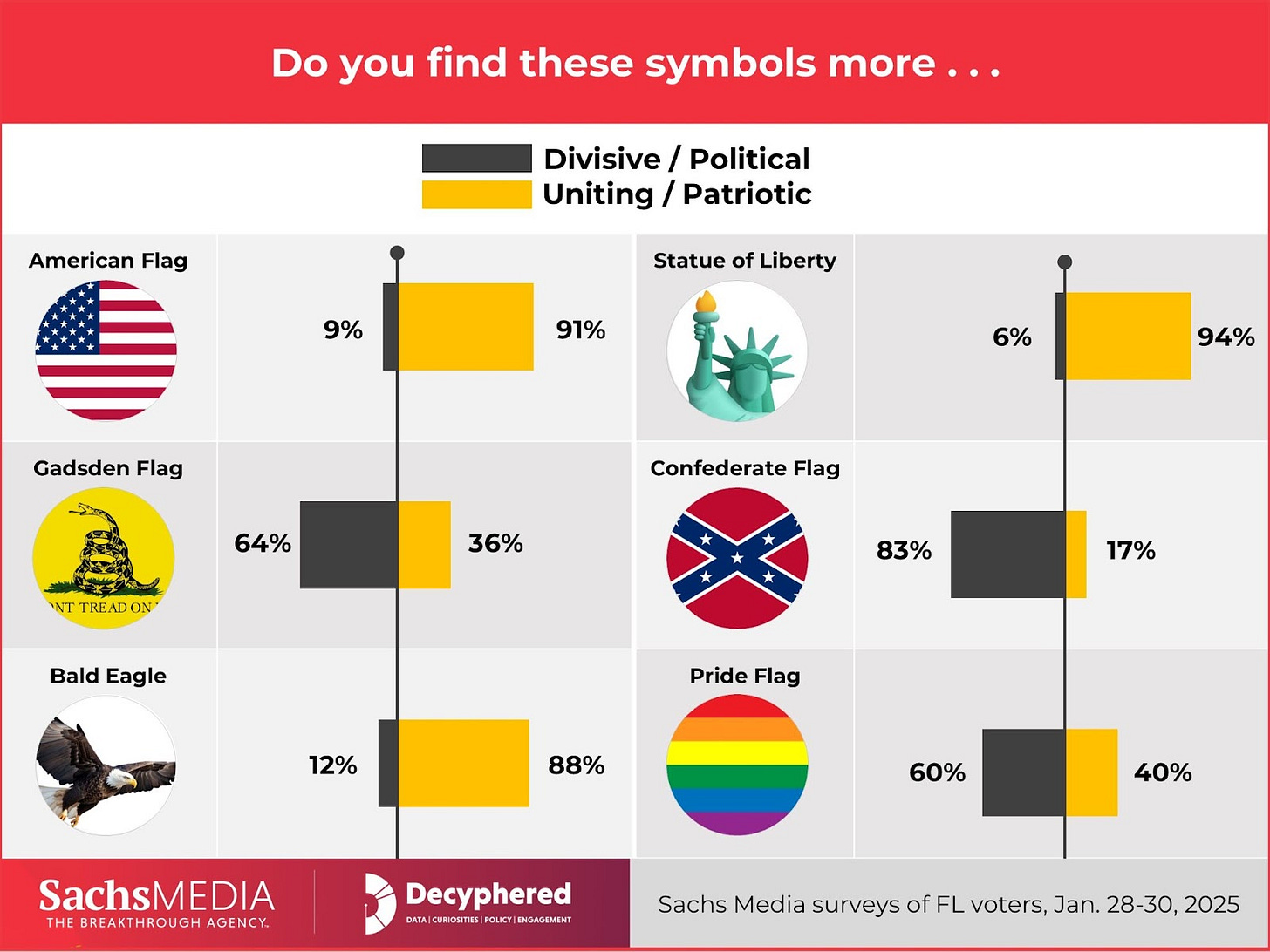This flag is your flag, this flag is my flag
Fractured perceptions of national symbols, and where to find some common ones
If you drive past a home with garden gnomes in the yard or wind chimes hanging from the porch, there’s no way to know just from those accessories whether the people who live there are Republicans or Democrats — both are equally likely to display gnomes or chimes.
Pass a house with string lights? A risk-averse gambler wouldn’t place a bet on the political leaning of those occupants, either. Our latest survey, conducted January 28-30, found that 43% of homes adorned with string lights are occupied by a Democrat, but that’s only a sniff above their share of Florida’s population overall. So string lights are about equally favored by members of all parties.
And then there’s flags.
Approximately 4 in 10 Florida voters are registered as Republicans. But if you walk past a mailbox showing an American flag, the odds are twice as high that the home belongs to a Republican than to a Democrat.
Symbols of American identity are a kind of national shorthand. The American flag in particular represents freedom, sacrifice, and unity — something we could all rally around, no matter where we stood on tax rates or social issues. Something we could all hold as our collective banner while arguing for how to properly or best actualize the American promise.
But increasingly, symbols of a truly shared American identity are harder to find.
My sister asked me to run this question on our survey. As an actor with roots in Los Angeles, a business in Atlanta, and a home in more rural North Georgia, she’s noticed a palpable shift in the vibe between neighborhoods in each locale. Specifically, the more conservative an area, the more American flags — and the more liberal an area, the more of all other kinds of flags.
Neighborhood flavors are great; it would be so dreary if every place looked like every other place. But when a country loses a sense of common ownership over its national symbols, it risks losing something bigger: a sense of cohesion, a shared story, and maybe even the ability to pull together in times of crisis, when unity matters most. All American presidential candidates, Republicans and Democrats alike, pledge their allegiance to the American flag. Yet it's clear that many Americans now feel that the very emblem of our nation has been co-opted into a partisan one.
If some Americans are left feeling that the American flag isn’t theirs, then what is? What other symbols - whether unifying or divisive - express people’s identities in 2025?
Our survey found that 1 in 11 Florida homes (9%) have “another” flag on display outside – such as LGBTQ pride flags, the Gadsden “Don’t Tread On Me” flag, a political banner, or even the Confederate flag. And among these homes flying an alternative flag, half (50%) belong to Democrats. Indeed, 14% of Democrats but just 7% of Republicans fly “another” flag, making Democrats twice as likely as Republicans to display some flag other than the American flag at their home.
There are exceptions, of course, particularly during campaign seasons: 1 in 3 homes with a flag other than the American flag belong to Republicans (including this delightful Woodstock, Georgia, resident who decided that the best way to express his own feelings was to make quite clear his lack of concern about offending others … such as the parents of young children just learning to read).
Beyond asking people whether they themselves have flags, wind chimes, gnomes, or whatnot, we wanted to better understand whether the simple presence of various flags influences how people feel about the home itself.
To do that, we used an experimental design in which respondents were assigned to view one of three photographs of a house, identical but for the presence, or absence, of a flag. One-third saw a home with no flag at all, the next third saw a home with an American flag, and the final third saw the same home but with a pride flag instead.
We then asked people to imagine they were in the market to buy a home, and rate the image on a scale from 0 (not) to 10 (very) likely to consider. Here’s how it played out:
In the aggregate, the house with no flags was rated an average of 5.7 – just above “meh,” not loved and not hated. The American flag and pride flag houses weren’t far behind, at 5.4 each. At first glance, it would appear that Americans aren’t judging homes by the flags they bear – but upon closer look, a partisan breakdown shows that’s not quite true.
Among Democrats, the no-flag house averaged a 5.6; the American flag house a 4.8; and the pride flag house at 6.3. Among Republicans, the no-flag house averaged a 5.9; the American flag house a 6.1; and the pride flag house a 4.2. Those without a party affiliation were somewhere in between – preferring no flag (5.6) over a home with the American flag (5.2), but placing pride flag homes the highest (5.9).
The signal is fairly clear: Flags affect people’s view of a home’s beauty and appeal based on the viewer’s politics. Republicans somewhat favor the look of a home if it has an American flag, but largely reject the same home with a pride flag; Democrats, just the opposite.
In a separate survey of another 700 Florida voters, conducted around the same time, we asked people to share how they feel about the American flag and various other national, political, or social symbols. For each, the question was: Is this symbol more patriotic or unifying, or is it more political or divisive?
Overall, 91% view the American flag as more patriotic or unifying, while the remaining 9% said they feel it’s a more political or divisive symbol. This latter view is held by 16% of Democrats but just 4% of Republicans and 5% of nonpartisans.
The bald eagle is seen as unifying by 88% overall, including 76% of Democrats and 99% of Republicans; and the Statue of Liberty is seen as unifying by 94%, including 90% of Democrats and 99% of Republicans.
The final three symbols we tested were all viewed as more divisive than unifying: the Confederate flag, the Gadsden flag, and the pride flag.
In the case of the Confederate flag, that response is both expected and warranted. Even if a person feels some affinity for the “Southern Cross,” it was created as the opposite of a unifying American symbol – quite literally, this flag represented the intended fracture of the United States into two separate nations. Most Floridians (83%) agree that the Confederate flag is indeed more divisive, a view shared by 90% of Democrats, 79% of nonpartisans, and 77% of Republicans.
The Gadsden flag, which was designed in 1775 and used by the Continental Marines during the American Revolution, was born as a symbol of resistance against British rule and is today associated with libertarianism, personal freedoms, and skepticism of governmental authority. It’s also seen as divisive by nearly 2 in 3 (64%), including 79% of Democrats, 53% of nonpartisans, and 53% of Republicans.
Unlike the other symbols we tested, the pride flag has never been an official symbol of any of our various governments. The six-color version of this flag used in this survey was introduced in 1978 to celebrate diversity and pride within the gay and lesbian community, and has since been associated with related legal and social movements.
The survey choices we offered here may be too binary – it’s likely there are people who feel accepting or neutral toward the pride flag and find it neither political/divisive nor patriotic/unifying. But sans the option to select otherwise, Floridians lean toward the view that this is a political and divisive symbol (58%) rather than a patriotic and unifying one (42%). Predictably, more Republicans find it political/divisive (87%) than do nonpartisans (64%) and Democrats (28%).
Regardless of where people stand regarding the American flag today, a plurality feel that its meaning has become more divisive over time (44%), while 40% feel its meaning has remained the same and 15% believe its meaning has become more unifying.
This is perhaps where the most important partisan differences are seen. More than 1 in 3 Republicans (35%) feel the American flag has become more unifying over time, while just 1 in 4 believe it’s become more divisive. But among Democrats, just 2% believe the flag has become more unifying while a staggering two-thirds (66%) consider it more divisive.
In other words, in a time of heightened partisanship and discord, the nation is on a trajectory where even the most basic symbol of national unity can cause feelings of divisiveness.
So where do we go from here?
It seems music may be part of the answer. Asked which songs inspire a sense of pride or patriotism in them, nearly everyone (93%) identified at least one. These include the Star-Spangled Banner (81%), God Bless America (73%), America the Beautiful (73%), America (My Country, ’Tis of Thee) (68%), and This Land is Your Land (68%), even with its political undertones. A full 6 in 10 (60%) say all of these songs resonate positively.
Symbols shape our collective identity. Yet in today’s America, so much is seen through a partisan lens. Where one person sees pride, another sees exclusion. Where one expresses inclusion, another feels pushed away.
We may need to step back and refocus on the commonalities that our preferred symbols represent — freedom, courage, and the pursuit of a better future together.
If garden gnomes are what it takes to find common ground, then let them stand as tiny ambassadors of unity.
Because in the end, it’s usually not the symbols themselves that divide us — it’s how we interpret them. And maybe, a shared laugh or a warm conversation under the glow of string lights with a neighbor who flies a different flag can remind us that we have more in common than we think.












Thanks for the work you are putting in. I appreciate folks working on uniting us. Tell everyone hello!